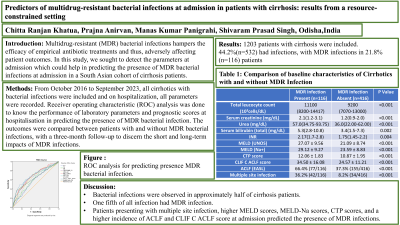Sunday Poster Session
Category: Liver
P1210 - Predictors of Multidrug-Resistant Bacterial Infections at Admission in Patients with Cirrhosis: Results From a Resource-Constrained Setting
Sunday, October 27, 2024
3:30 PM - 7:00 PM ET
Location: Exhibit Hall E

Has Audio
- CK
Chitta Ranjan Khatua, MBBS, MD, DM
Maharaj Krushna Chandra Gajapati Medical College
Berhampur, Orissa, India
Presenting Author(s)
Chitta Ranjan Khatua, MBBS, MD, DM1, Prajna Anirvan, DM, MD, MBBS2, Manas Kumar Panigrahi, MD3, Shivaram Prasad Singh, MBBS, MD, DM, FACG4
1Maharaj Krushna Chandra Gajapati Medical College, Berhampur, Orissa, India; 2Kalinga Gastroenterology Foundation, Cuttak, Orissa, India; 3All India Institute of Medical Sciences, Bhubaneshwar, Orissa, India; 4Kalinga Gastroenterology Foundation, Cuttack, Orissa, India
Introduction: Multidrug-resistant (MDR) bacterial infections cause a significant challenge in cirrhosis, hampering the efficacy of empirical antibiotic treatments and thus, adversely affecting patient outcomes. In this study, we sought to detect the parameters at admission which could help in predicting the presence of multidrug-resistant bacterial infections at admission, and also help a lot in choosing the appropriate empirical antimicrobial and better outcome in a South Asian cohort of cirrhosis patients.
Methods: From October 2016 to September 2023, all cirrhosis patients with bacterial infections were included and on hospitalization, all parameters were recorded. Receiver operating characteristic (ROC) analysis was done to know the performance of laboratory parameters and prognostic scores at hospitalisation in predicting the presence of MDR bacterial infection. The outcomes were compared between patients with and without MDR bacterial infections, with a three-month follow-up to discern the short and long-term impacts of MDR infections.
Results: Out of 1203 patients, 44.2% (n=532) had infections, with MDR infections prevalent in 21.8% (n=116). Urinary tract infection (UTI) was the most common at 73.3%, followed by pneumonia at 30.2%, spontaneous bacterial peritonitis at 76.7%, skin and soft tissue infection at 11.2%. On ROC analysis, the AUC of TLC (0.584), (0.584), INR (0.634), serum creatinine (0.676), urea (0.666), Model for End-Stage Liver Disease (MELD) (0.680), MELD-Na (0.676), Child-Turcotte-Pugh (CTP) score (0.584), presence of acute-on-chronic liver failure (ACLF) (EASL CLIF) (0.644), CLIF ACLF score (0.692), and multiple site infections (.642) at admission performed better with MDR bacterial infection. Further patients with MDR infections had higher MELD scores(p< 0.001), MELD-Na(p< 0.001) scores, CTP scores(p< 0.001), higher incidence of ACLF(p< 0.001), higher CLIF ACLF score(p< 0.001), multiple site infections(p< 0.001), higher serum creatinine(p< 0.001), urea(p< 0.001), bilirubin(p< 0.001), total leucocyte count (TLC) (p=0.032), INR(p=0.004), increased hospital mortality(p< 0.001), and decreased survival at 28 day(p< 0.001) and 90 day(p< 0.001).
Discussion: Bacterial infections were observed in approximately half of cirrhosis patients, with on fifth having MDR infection. Patients with multiple site infection, higher MELD scores, MELD-Na scores, CTP scores, and a higher incidence of ACLF and CLIF C ACLF score at admission predicted the presence of MDR bacterial infections.
Disclosures:
Chitta Ranjan Khatua, MBBS, MD, DM1, Prajna Anirvan, DM, MD, MBBS2, Manas Kumar Panigrahi, MD3, Shivaram Prasad Singh, MBBS, MD, DM, FACG4. P1210 - Predictors of Multidrug-Resistant Bacterial Infections at Admission in Patients with Cirrhosis: Results From a Resource-Constrained Setting, ACG 2024 Annual Scientific Meeting Abstracts. Philadelphia, PA: American College of Gastroenterology.
1Maharaj Krushna Chandra Gajapati Medical College, Berhampur, Orissa, India; 2Kalinga Gastroenterology Foundation, Cuttak, Orissa, India; 3All India Institute of Medical Sciences, Bhubaneshwar, Orissa, India; 4Kalinga Gastroenterology Foundation, Cuttack, Orissa, India
Introduction: Multidrug-resistant (MDR) bacterial infections cause a significant challenge in cirrhosis, hampering the efficacy of empirical antibiotic treatments and thus, adversely affecting patient outcomes. In this study, we sought to detect the parameters at admission which could help in predicting the presence of multidrug-resistant bacterial infections at admission, and also help a lot in choosing the appropriate empirical antimicrobial and better outcome in a South Asian cohort of cirrhosis patients.
Methods: From October 2016 to September 2023, all cirrhosis patients with bacterial infections were included and on hospitalization, all parameters were recorded. Receiver operating characteristic (ROC) analysis was done to know the performance of laboratory parameters and prognostic scores at hospitalisation in predicting the presence of MDR bacterial infection. The outcomes were compared between patients with and without MDR bacterial infections, with a three-month follow-up to discern the short and long-term impacts of MDR infections.
Results: Out of 1203 patients, 44.2% (n=532) had infections, with MDR infections prevalent in 21.8% (n=116). Urinary tract infection (UTI) was the most common at 73.3%, followed by pneumonia at 30.2%, spontaneous bacterial peritonitis at 76.7%, skin and soft tissue infection at 11.2%. On ROC analysis, the AUC of TLC (0.584), (0.584), INR (0.634), serum creatinine (0.676), urea (0.666), Model for End-Stage Liver Disease (MELD) (0.680), MELD-Na (0.676), Child-Turcotte-Pugh (CTP) score (0.584), presence of acute-on-chronic liver failure (ACLF) (EASL CLIF) (0.644), CLIF ACLF score (0.692), and multiple site infections (.642) at admission performed better with MDR bacterial infection. Further patients with MDR infections had higher MELD scores(p< 0.001), MELD-Na(p< 0.001) scores, CTP scores(p< 0.001), higher incidence of ACLF(p< 0.001), higher CLIF ACLF score(p< 0.001), multiple site infections(p< 0.001), higher serum creatinine(p< 0.001), urea(p< 0.001), bilirubin(p< 0.001), total leucocyte count (TLC) (p=0.032), INR(p=0.004), increased hospital mortality(p< 0.001), and decreased survival at 28 day(p< 0.001) and 90 day(p< 0.001).
Discussion: Bacterial infections were observed in approximately half of cirrhosis patients, with on fifth having MDR infection. Patients with multiple site infection, higher MELD scores, MELD-Na scores, CTP scores, and a higher incidence of ACLF and CLIF C ACLF score at admission predicted the presence of MDR bacterial infections.
Disclosures:
Chitta Ranjan Khatua indicated no relevant financial relationships.
Prajna Anirvan indicated no relevant financial relationships.
Manas Kumar Panigrahi indicated no relevant financial relationships.
Shivaram Prasad Singh indicated no relevant financial relationships.
Chitta Ranjan Khatua, MBBS, MD, DM1, Prajna Anirvan, DM, MD, MBBS2, Manas Kumar Panigrahi, MD3, Shivaram Prasad Singh, MBBS, MD, DM, FACG4. P1210 - Predictors of Multidrug-Resistant Bacterial Infections at Admission in Patients with Cirrhosis: Results From a Resource-Constrained Setting, ACG 2024 Annual Scientific Meeting Abstracts. Philadelphia, PA: American College of Gastroenterology.
